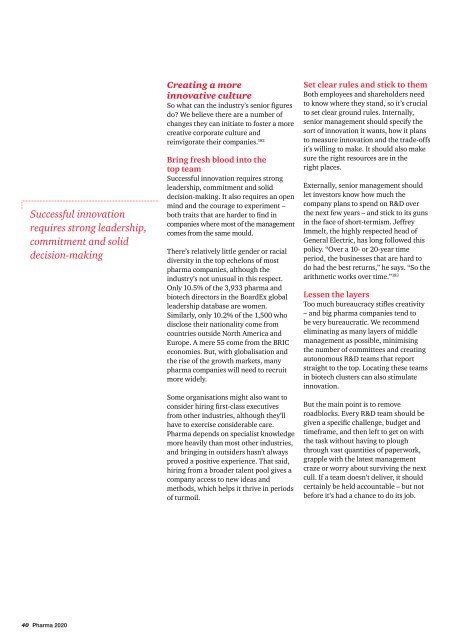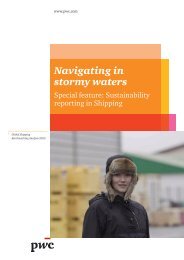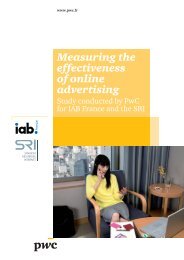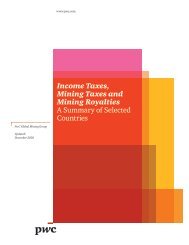From vision to decision Pharma 2020 - pwc
From vision to decision Pharma 2020 - pwc
From vision to decision Pharma 2020 - pwc
You also want an ePaper? Increase the reach of your titles
YUMPU automatically turns print PDFs into web optimized ePapers that Google loves.
Successful innovation<br />
requires strong leadership,<br />
commitment and solid<br />
<strong>decision</strong>-making<br />
Creating a more<br />
innovative culture<br />
So what can the industry’s senior figures<br />
do? We believe there are a number of<br />
changes they can initiate <strong>to</strong> foster a more<br />
creative corporate culture and<br />
reinvigorate their companies. 182<br />
Bring fresh blood in<strong>to</strong> the<br />
<strong>to</strong>p team<br />
Successful innovation requires strong<br />
leadership, commitment and solid<br />
<strong>decision</strong>-making. It also requires an open<br />
mind and the courage <strong>to</strong> experiment –<br />
both traits that are harder <strong>to</strong> find in<br />
companies where most of the management<br />
comes from the same mould.<br />
There’s relatively little gender or racial<br />
diversity in the <strong>to</strong>p echelons of most<br />
pharma companies, although the<br />
industry’s not unusual in this respect.<br />
Only 10.5% of the 3,933 pharma and<br />
biotech direc<strong>to</strong>rs in the BoardEx global<br />
leadership database are women.<br />
Similarly, only 10.2% of the 1,500 who<br />
disclose their nationality come from<br />
countries outside North America and<br />
Europe. A mere 55 come from the BRIC<br />
economies. But, with globalisation and<br />
the rise of the growth markets, many<br />
pharma companies will need <strong>to</strong> recruit<br />
more widely.<br />
Some organisations might also want <strong>to</strong><br />
consider hiring first-class executives<br />
from other industries, although they’ll<br />
have <strong>to</strong> exercise considerable care.<br />
<strong>Pharma</strong> depends on specialist knowledge<br />
more heavily than most other industries,<br />
and bringing in outsiders hasn’t always<br />
proved a positive experience. That said,<br />
hiring from a broader talent pool gives a<br />
company access <strong>to</strong> new ideas and<br />
methods, which helps it thrive in periods<br />
of turmoil.<br />
Set clear rules and stick <strong>to</strong> them<br />
Both employees and shareholders need<br />
<strong>to</strong> know where they stand, so it’s crucial<br />
<strong>to</strong> set clear ground rules. Internally,<br />
senior management should specify the<br />
sort of innovation it wants, how it plans<br />
<strong>to</strong> measure innovation and the trade-offs<br />
it’s willing <strong>to</strong> make. It should also make<br />
sure the right resources are in the<br />
right places.<br />
Externally, senior management should<br />
let inves<strong>to</strong>rs know how much the<br />
company plans <strong>to</strong> spend on R&D over<br />
the next few years – and stick <strong>to</strong> its guns<br />
in the face of short-termism. Jeffrey<br />
Immelt, the highly respected head of<br />
General Electric, has long followed this<br />
policy. “Over a 10- or 20-year time<br />
period, the businesses that are hard <strong>to</strong><br />
do had the best returns,” he says. “So the<br />
arithmetic works over time.” 183<br />
Lessen the layers<br />
Too much bureaucracy stifles creativity<br />
– and big pharma companies tend <strong>to</strong><br />
be very bureaucratic. We recommend<br />
eliminating as many layers of middle<br />
management as possible, minimising<br />
the number of committees and creating<br />
au<strong>to</strong>nomous R&D teams that report<br />
straight <strong>to</strong> the <strong>to</strong>p. Locating these teams<br />
in biotech clusters can also stimulate<br />
innovation.<br />
But the main point is <strong>to</strong> remove<br />
roadblocks. Every R&D team should be<br />
given a specific challenge, budget and<br />
timeframe, and then left <strong>to</strong> get on with<br />
the task without having <strong>to</strong> plough<br />
through vast quantities of paperwork,<br />
grapple with the latest management<br />
craze or worry about surviving the next<br />
cull. If a team doesn’t deliver, it should<br />
certainly be held accountable – but not<br />
before it’s had a chance <strong>to</strong> do its job.<br />
40 <strong>Pharma</strong> <strong>2020</strong>
















